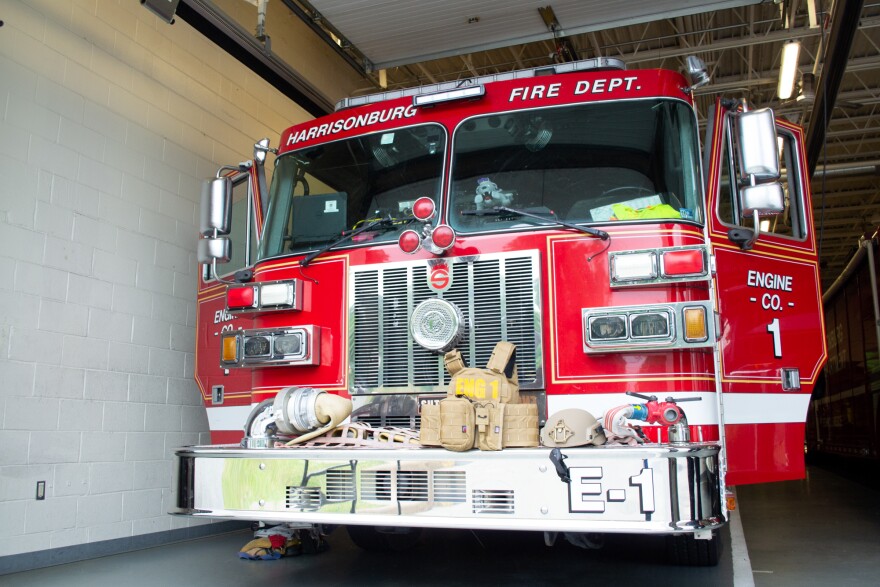In an era when mass shootings and gun violence have become commonplace, some local fire departments are investing in body armor. WMRA's Randi B. Hagi reports.
The Harrisonburg Fire Department has trained for active shooter events alongside law enforcement for years. Recently, though, they added a key piece of equipment to each fire engine and their ladder truck – new ballistic protection gear.
STEPHEN MORRIS: What we chose to go with is what is considered level four body armor. It's a plate that is designed to stop rifle rounds.
Stephen Morris is the deputy fire chief. He showed me a khaki-colored vest with adjustable straps and heavy, rigid plates on the chest and back.

MORRIS: Body armor has different levels. What police officers wear day-in and day-out, the soft body armor, is more for handgun rounds. … You would see this on officers that are going into active shooter situations, SWAT teams, they would wear this heavier-duty armor. Obviously, with the trends that are happening out there with active shooter situations, we decided to go with the highest protection for our staff. That also includes a helmet – a ballistic helmet.
Previously, they had a limited amount of hand-me-down body armor from the police department that was rated for a lower level of protection.
MORRIS: … and we didn't have enough to place it on every apparatus, so it was strategically placed so that if a situation occurred, we had to get it to the scene. Now, we have enough that every apparatus has their own assigned to them.
The need for this kind of equipment isn't hypothetical. Harrisonburg Fire Department personnel were called to the shooting at a party last October that wounded eight people. And Morris himself responded to the Bridgewater College shooting to assist other agencies.
The independent research group Gun Violence Archive reports that there have been 295 mass shootings in the U.S. so far this year. By their tallies, the annual totals of mass shootings in America have remained above 600 per year since 2020. And that wouldn't even include tragedies like the Bridgewater College shooting, since the organization defines a mass shooting as an incident in which four or more people are shot, not including the shooter.

During an active shooter situation, the fire department's role is to provide quick medical care to the injured.
MORRIS: We operate in what we call a rescue task force concept. Say one of our engines arrives with a staffing of three, they would team up with some law enforcement personnel, for security, to enter the scene to start providing that treatment, and then extricating the victims out to be transported to the hospital.
He said the practices of fire services have evolved along with the prevalence of shootings.
MORRIS: Before, the fire department would get dispatched for this, we'd stage until the shooter has been apprehended or whatever, and then we'd go into the scene. Well, people were dying. … So we've learned from those instances that we have to get our personnel in there quicker to provide that basic life support and stop the bleeding. We have to do a little risk management with that, obviously, understanding we're not necessarily going in where active shooting's occurring, but we're going into a place that isn't totally secure either, so we're taking on a little bit more risk than we used to in these situations.
Staunton Fire & Rescue is another local agency that invested in this equipment. Deputy Chief Perry Weller said they bought level four 'plate carriers,' or armored vests, about four years ago, but thankfully have not had to use them yet.

PERRY WELLER: As a region, the fire and rescue agencies started talking with the area police departments about establishing what they call a rescue task force … and then our personnel just didn't feel comfortable to be out in the open, for lack of a better term, without any type of protection. This is why we decided to go with that style carrier.
It's hard to determine how common this equipment is among fire departments. The Virginia Department of Fire Programs, which provides training and state-funded grants to local agencies, doesn't track what kind of equipment they carry. It was through one of their "aid to locality" grants that Harrisonburg was able to purchase the body armor – it cost $40,000 for 29 sets.
The physical and psychological weight of body armor is an indicator of the shifting responsibilities of first responders.
WELLER: You know, definitely, when I started in '97, it was few and far between if you ever heard about any kind of active shooter event. So it's definitely, the hazards have changed over the years.
MORRIS: I started volunteering at age 16, so 34 years ago, but I started it as a career 27 [years ago]. Twenty-seven years ago, you know, this would not have been a thought of, "hey, we need to carry body armor on our fire apparatus." Obviously, back in 1999, 2000, when Columbine occurred, it brought a little bit of attention to it, but it still didn't bring the attention to it that we have today.
Morris noted that their mission has never changed – that is to save lives.



